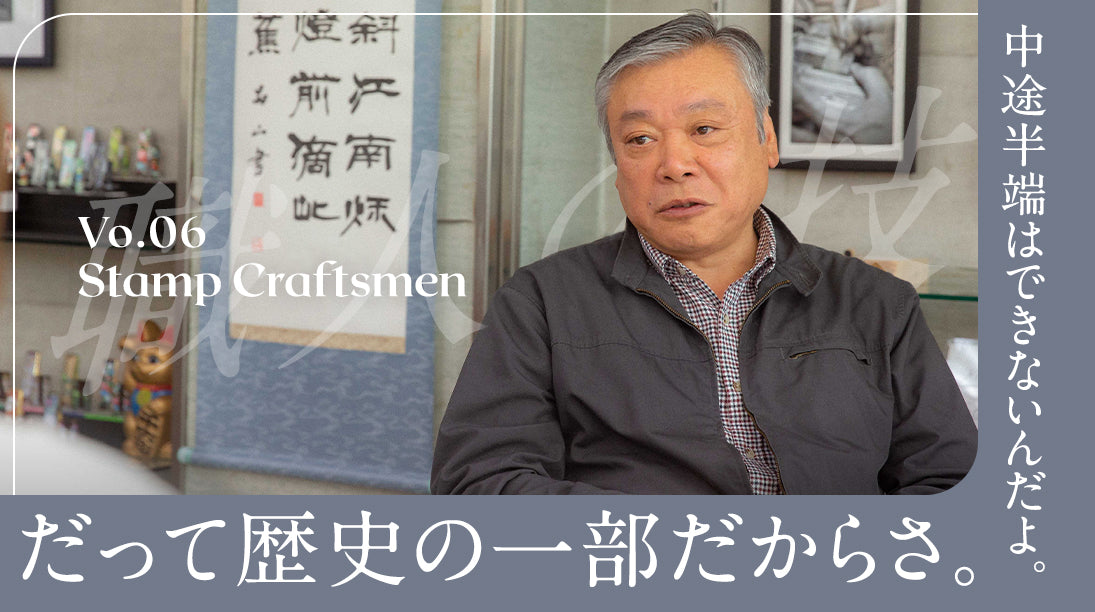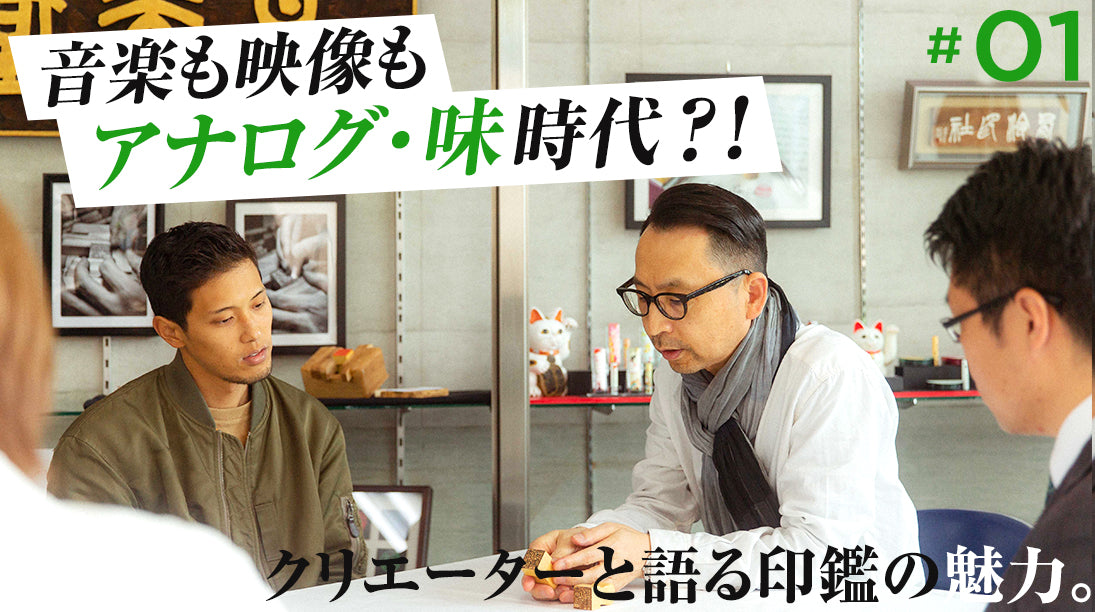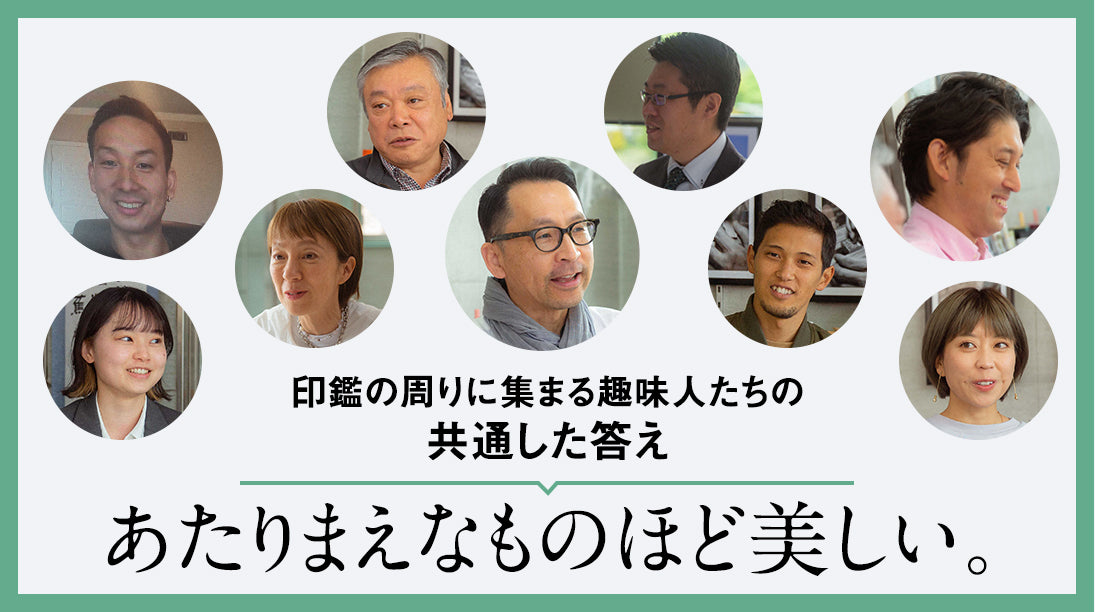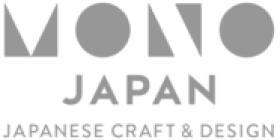
06: You can't do it half-heartedly, because it's part of history.
Ieyasu: Genjimetal has become a hot topic and has been getting more interviews. It certainly is a masterpiece that has evolved quite a bit in the history of seals, but what do you think is the value of Genjimetal?
Harada: Of course the structure is wonderful and remarkable, but I think what's most impressive is that the letters were designed by hand by craftsmen.

Ieyasu: Surprisingly, the origin of the seal!?
Harada: That's right. To make it possible for the characters to disappear and appear, both the characters and the white space need to be connected. But as you know, a seal is a character. And it is a certain thing backed by history, technique, and meaning. Only a craftsman can create new characters while following the traditions that have been passed down within those constraints, and see if they can become a new tradition in the future. Right, Kobayashi-san, Ninomiya-san?


Ieyasu: As a seal maker, did you have any reservations when you heard that letters would emerge from metal?
Kobayashi: I had heard about it from President Harada beforehand, and I thought it was rather interesting. After all, the people who process the metal are craftsmen, right? It's interesting to see the latest craftsmanship come together with our traditional techniques. However, once I started, it was much harder than I thought!
Ieyasu: What was the most difficult part?
Kobayashi: Seal script is a typeface that has existed and been used since ancient times, and you can't just change it in your own way. For example, if you reversed the hiragana character "ku", it would no longer make sense, right? It's that difficult. Because everything has a meaning. It can't be easily altered.


Kobayashi: But for Genjimetal, in order to make this system a reality, it was necessary for not only the letters but also the white space to all be connected. In other words, the letters had to have appropriate breaks. Otherwise, there would be parts of the white space that would be left behind like islands. So it was up to me to decide what to change.
Harada: What you're looking at now is an enlarged print, but it's actually a small 18mm circle. You can see how intricate it is.



Ninomiya: I saw everything Kobayashi-san had done and started making things myself. For example, the framed letters respect the mechanical feel of genjimetal, using straight lines based on seal script and seal image script, and even using the edges of the frame as part of the letters. Also, I thought the hard texture of the metal was like a sword, so I deliberately designed the katana moji (sword characters), which are not commonly used for stamps, based on the characters carved into the side of a stamp, which have the feel of a sword that has been scraped off.
Kobayashi: When you create characters, you have to break away from conventional theory in a sense.
Harada: I'm sorry for asking such a big favor!
Kobayashi: For example, I don't want to connect this part, but I have to. I have to connect it to show the meaning of the characters, and I need some gaps, but if they're too regular it doesn't look beautiful, and so on.


Ninomiya: I also worked on the Tensho Koin style (an ancient seal style), but President Harada asked me to make something more traditional. He originally ordered something that didn't look like a stamp, but...
This old seal script style is a typeface that gets its flavor from pools of ink, and I used images of characters that have been corroded and broken, or characters that have been torn off due to aging, to come up with the breaks in the characters.
Kobayashi: I think about what it would look like if I were to actually write it with a brush, and I think about the order of strokes and where to break. It's quite nerve-wracking.

Harada: When it comes to lettering design, it's important who is involved. Genjimetal is basically expensive and it's something that will last a lifetime, so we want to create something nice and give it to them.
Kobayashi: When I was making the letters for genjimetal, I asked the president to make them, but they are not exactly what you would call accurate letters. They are arrangements, with connections and breaks adjusted to allow for a structure where they disappear and reappear. They are letters for this world.

Harada: The reason why Kobayashi's story has weight is because of this attitude. You can just make some incisions and finish it. You might be able to do it even if you don't know the history of writing. But that's not the case.
Kobayashi: The history of writing is the same as the history of people. It has undergone various changes and forms to reach the present. And now it is something that will continue into the future. It is in the middle of evolution. Cutting it off or simply creating something that is good for the time being is not an evolution that will lead to the future.
Harada: It is our role to carry on the history of seals.
Kobayashi: It's part of evolution, so we're creating the next thing to stand alongside the past in the museum. I think you could say we're making history. In recent years, it's said that the reason for the decline of seals is digitalization, but the problem is that they became office supplies even before that. Originally, seals were a substitute for oneself, something to express oneself, so looking at a seal tells you about a person's character. When you stamp a seal, it's a contract or an important moment in your life, right? A crooked or chipped seal reveals how you perceive it.
In the old days, they weren't called stamp makers, but rather seal makers. Only important people could have stamps, so they were made on the orders of those people. So, swords and paper were called sword makers and mounting makers.

Yamashita: Everything is connected, and I think that's the key word. Japanese culture, like the mirrors in shrines, is also a culture that reflects things as they are.
Kobayashi: You always look at the seal before pressing it, right? Otherwise you can't tell the top and bottom or the direction. That's for practical reasons, but the seal is a substitute for you, so you press it as if it were reflecting you. The seal we made this time has a mirror-like surface, which really embodies that meaning.
Ninomiya: It's interesting to see yourself reflected in the image. If you want to get a larger image, you can make it concave and create it like a wide-angle lens.
Harada: It looks like the next challenge is about to begin!

Ninomiya: Kanji are popular overseas too. People are especially interested when you explain their meaning. We sometimes write names in calligraphy at small events and hand them out, and people are fascinated. It's important to convey the value of stamps, but it's also important to convey the meaning of kanji and characters in the first place.








